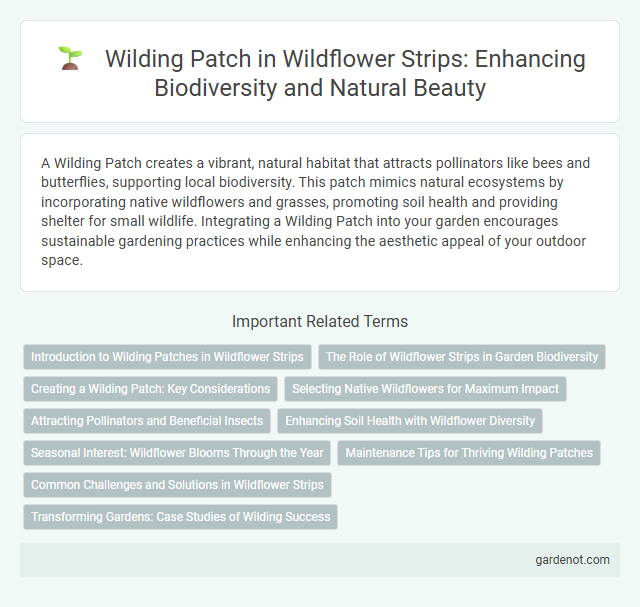A Wilding Patch creates a vibrant, natural habitat that attracts pollinators like bees and butterflies, supporting local biodiversity. This patch mimics natural ecosystems by incorporating native wildflowers and grasses, promoting soil health and providing shelter for small wildlife. Integrating a Wilding Patch into your garden encourages sustainable gardening practices while enhancing the aesthetic appeal of your outdoor space.
Introduction to Wilding Patches in Wildflower Strips
Wilding patches within wildflower strips serve as essential biodiversity hotspots, promoting native flora growth and supporting pollinator populations such as bees and butterflies. These patches enhance ecosystem resilience by providing varied habitats, improving soil health through natural processes, and increasing overall landscape connectivity. Implementing wilding patches strategically optimizes the ecological benefits of wildflower strips in agricultural and urban settings.
The Role of Wildflower Strips in Garden Biodiversity
Wildflower strips serve as crucial habitats that boost garden biodiversity by providing essential resources such as nectar, pollen, and shelter for pollinators like bees, butterflies, and hoverflies. These strips support a diverse range of native plant species, promoting ecosystem resilience and enhancing natural pest control by attracting predatory insects. Incorporating wilding patches into garden design fosters ecological balance and contributes to the conservation of pollinator populations vital for plant reproduction.
Creating a Wilding Patch: Key Considerations
Creating a wilding patch requires careful site selection, prioritizing areas with good sunlight exposure and well-drained soil to support native wildflower growth. Choosing a diverse seed mix of locally sourced wildflower species enhances biodiversity and attracts pollinators such as bees and butterflies. Regular maintenance in the first two years, including controlling invasive weeds and avoiding excessive mowing, ensures successful establishment and long-term ecosystem benefits.
Selecting Native Wildflowers for Maximum Impact
Selecting native wildflowers for a wilding patch enhances biodiversity and supports local pollinators by providing essential nectar sources. Prioritize species like Echinacea purpurea, Asclepias tuberosa, and Rudbeckia hirta that thrive in your region's soil and climate conditions. Incorporating a variety of bloom times ensures continuous floral resources, maximizing ecological impact throughout the growing season.
Attracting Pollinators and Beneficial Insects
Wilding patches within wildflower strips serve as vital habitats that attract a diverse array of pollinators and beneficial insects, including bees, butterflies, hoverflies, and ladybugs. These insects enhance pollination efficiency for nearby crops and contribute to natural pest control by preying on harmful pests. Creating wilding patches with native flowering plants rich in nectar and pollen supports ecosystem biodiversity and increases agricultural productivity.
Enhancing Soil Health with Wildflower Diversity
Wildflower strips create a wilding patch that enhances soil health by increasing biodiversity and promoting beneficial microorganisms. Diverse root structures improve soil aeration and nutrient cycling, leading to richer organic matter content. This natural approach supports sustainable agriculture by reducing soil erosion and boosting ecosystem resilience.
Seasonal Interest: Wildflower Blooms Through the Year
Wilding patches feature diverse wildflower blooms that provide vibrant seasonal interest from early spring through late autumn. Species such as bluebells and primroses brighten spring landscapes, while later months showcase poppies, cornflowers, and asters. These varied blooms support biodiversity by offering continuous forage for pollinators throughout the entire growing season.
Maintenance Tips for Thriving Wilding Patches
Regularly removing invasive species and avoiding excessive mowing support the health of wilding patches. Monitoring soil moisture and nutrient levels ensures optimal conditions for native wildflowers to flourish. Implementing seasonal weeding and allowing natural seed dispersal promotes biodiversity and long-term sustainability.
Common Challenges and Solutions in Wildflower Strips
Wildflower strips often face challenges such as invasive species intrusion, inconsistent seed germination, and soil nutrient imbalances that hinder plant diversity and growth. Implementing targeted weed management strategies, selecting region-specific native seed mixes, and conducting regular soil testing help optimize vegetation health and ecological benefits. Adaptive maintenance practices, including periodic mowing and re-seeding, improve resilience and long-term sustainability of wilding patches.
Transforming Gardens: Case Studies of Wilding Success
Wilding patches have transformed urban gardens into thriving ecosystems by introducing native wildflower strips that promote biodiversity and support pollinators. Case studies reveal significant increases in insect populations, including bees and butterflies, enhancing natural pest control and soil health. These garden transformations demonstrate that integrating wildflower strips fosters resilient habitats and contributes to ecological balance in residential areas.
Wilding patch Infographic

 gardenot.com
gardenot.com